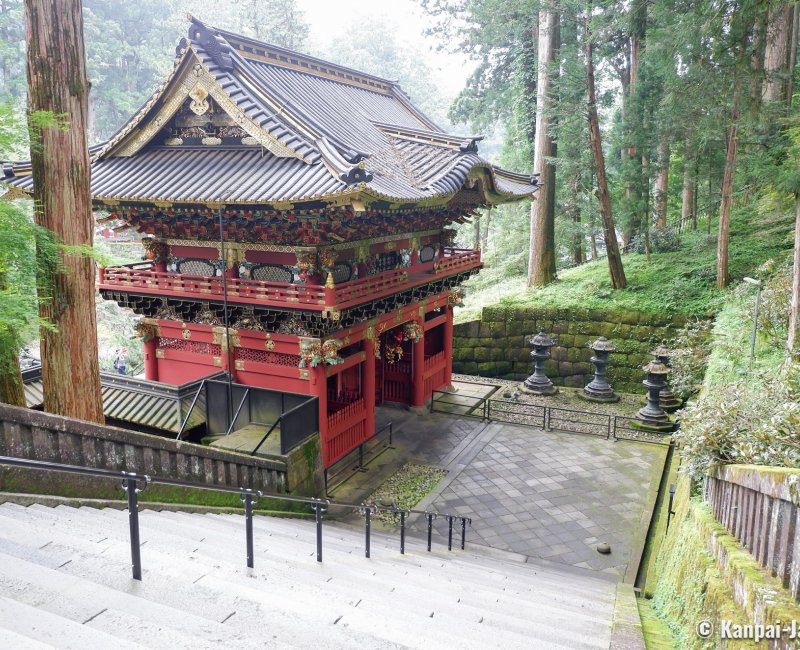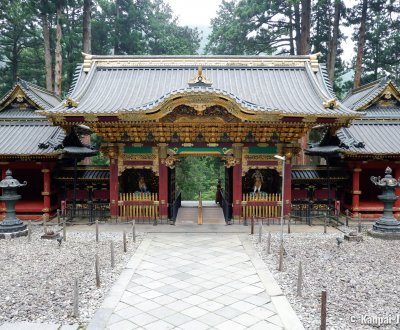Taiyuin
Shogun Tokugawa Iemitsu’s Mausoleum
Taiyuin is a Buddhist temple located in Nikko, in Tochigi prefecture in Japan. It shelters the grave of Tokugawa Iemitsu, secluded and nestled in a dense cedar forest, yet neighboring the city’s main touristic sites, providing a quiet visit imbued with spirituality. The mausoleum is part of the Rinno-ji complex and stands as a counterpart to the Toshogu, the great shrine dedicated to Ieyasu, Iemitsu’s grandfather.
Tokugawa Iemitsu (1604 – 1651) was a prominent figure of the Tokugawa dynasty and reigned at the beginning of the Edo period (1603 - 1868) as its third shogun. Following the steps of his grandfather Ieyasu, he pursued the repression of Christianism and was the initiator of the Sakoku, the total closure of the country that started in 1650 and only ended 2 centuries later.
In 1636, he commissioned monk Tenkai (1536 - 1643) to extend Nikko’s Toshogu, the largest mausoleum dedicated to Tokugawa Ieyasu (1543 – 1616). Tenkai also received the responsibility of constructing another mausoleum for Iemitsu.
Taiyu-in temple, named after Tokugawa Iemitsu’s posthumous name, was thus achieved after 14 years of work, in a style that clearly appears more influenced by Buddhism than by Shinto, and spreads on the side of the mountain, away from the road. It encompasses several large gates reminding of the Toshogu’s lavish architecture, but never outstanding it, as requested by Iemitsu, who was very keen to not overshadow is famous and venerated grandfather.
Rewarding ascension to the mausoleum
At the foot of a forestry hill, the Taiyuin can be visited alone or combined with Sanbutsudo, Rinno-ji’s main hall. The path is constituted by stone stairways whose landings are ornamented by an impressive Buddhist gate "-mon", each of them sided with guardian deities of the place. The ascension leads to a plaza where stands the last pavilion of the temple: Iemitsu’s grave.

1️⃣ First Gate Niomon
The Niomon gate indicates the entrance of Taiyuin and was named after the 2 Nio guardians, called Mishaku et Naraen. These 3.2 meters tall statues of ferocious warriors are used to impress visitors and ward off evil spirits. They form a complementary couple, with:
- Mishaku, on the right with the open mouth, seems to be saying the letter A that symbolizes the beginning of the cosmos, and,
- Naraen, on the left and mouth closed, as if saying the letter N, the last of the Japanese syllabary, also meaning the end of the universe.
Nearby, the purification pavilion Suibansha awaits for the ablutions, that is to say washing hands and mouth before proceeding to the visit. The pavilion’s ceiling is ornamented with an authentic painting by Kano Yasunobu (1614 - 1685) that pictures a dragon, a mystical creature usually associated with water.
2️⃣ Second gate Nitenmon
On the left, as stairway climbs to the landing where is standing the second gate named Nitenmon. Impressive and with a rich decoration, it is one of the biggest gates to admire in Nikko. One cannot just pass by it and its detailed contemplation requires some time.
Nitenmon protects the cardinal points and shelters 2 of the 4 Heavenly Kings, notably pictured with a green or red face:
- Jikokuten is "he who upholds" and watches over east,
- Zochoten, is "he who grows" and watches for dangers coming from the south; then,
- Fujin, the god of the wind, and,
- Raijin, the god of thunder.
This part of the temple is particularly beautiful, and the elevated standpoint offers a nice panorama on the cedar forest and the various vermilion pavilions that beautifully contrast amidst the green of nature. The impression of "seeing the world of the human from the heaven" is stunning and we recommend pausing at each landing of the stairways to enjoy the view.

In the vicinity, Tenbojo is a garden ornamented with lanterns 🏮 offered by the daimyo feudal lords of the times, as a testimony of their loyalty to the shogun. Moreover, the small pavilion of the Ryuko-in was once the residence of Kaji Sadayoshi, Iemitsu’s closest retainer.
3️⃣ Third gate Yashamon
Two turrets, Shoro (Bell tower) and Koro (Drum tower), frame the arrival on Yashamon gate, named in reference to the 4 Yasha guardians it shelters:
- Bidara,
- Abatsumara,
- Kendara; and,
- Umarokya.
Each of them is stationed at a cardinal point and guards the surrounding, to fulfill their pledge to protecting Buddha’s teachings. There are also many sculptures of peonies, a symbol of wealth and royalty. The most sacred buildings are not far away.
4️⃣ Fourth gate Karamon
The Karamon gate is quickly reached after Yashamon gate. Its architecture is of Chinese inspiration and its size smaller compared to the 3 first portals. No guardians here, as the dangers are now past and belong to the "world below". The carvings represent one dragon and two cranes on the round gable of the gate, called karahafu.
The prayer room Haiden and the main hall Honden are to be found just behind, protected by a Sukibei wall. Constructed in the Ishi-no-ma-zukuri architectural style, these gilded buildings are a sight to behold, as much for the subtleness of the ornaments as for their profusion.
Inside, the ceiling is taken over by 140 pictures of dragons, and the walls are painted with Karashishi lions. These pantings are the artworks of 2 talented artists of the Edo period: Kano Tanyu (1602 - 1674) and his brother Kano Yasunobu (1613 - 1685). The armor worn by Iemitsu is also displayed.
5️⃣ Last Gate Kokamon
Built in 1653, the Kokamon gate is guarding access to Iemitsu’s mausoleum. It style is rather unusual and was thus nicknamed Ryugumon (Gate of the Dragon Palace) probably due to the fact that the shogun was born during the year of the dragon.
The grave is oriented toward the Toshogu for Iemitsu to eternally show his respect to his grandfather.

A beautiful complement to Rinno-ji temple
While less frequented than the famous Toshogu, Taiyuin Mausoleum is also worth a visit, with its location in the dense cedar forest and off the beaten tracks of Nikko’s tourist crowds being additional assets. The buildings display a majestic beauty, a rich ornamentation and bear an important historical value.

